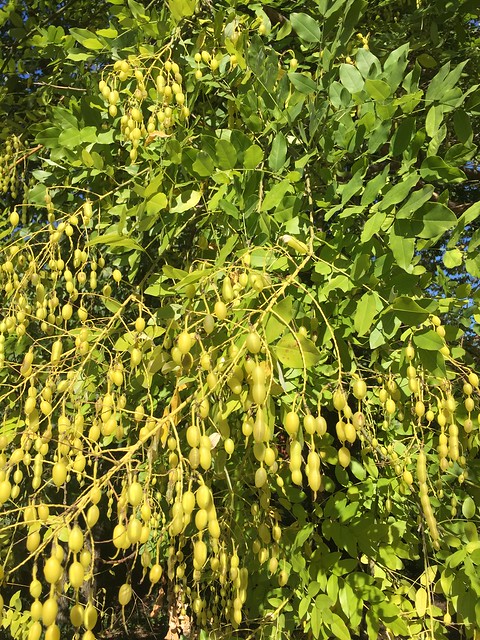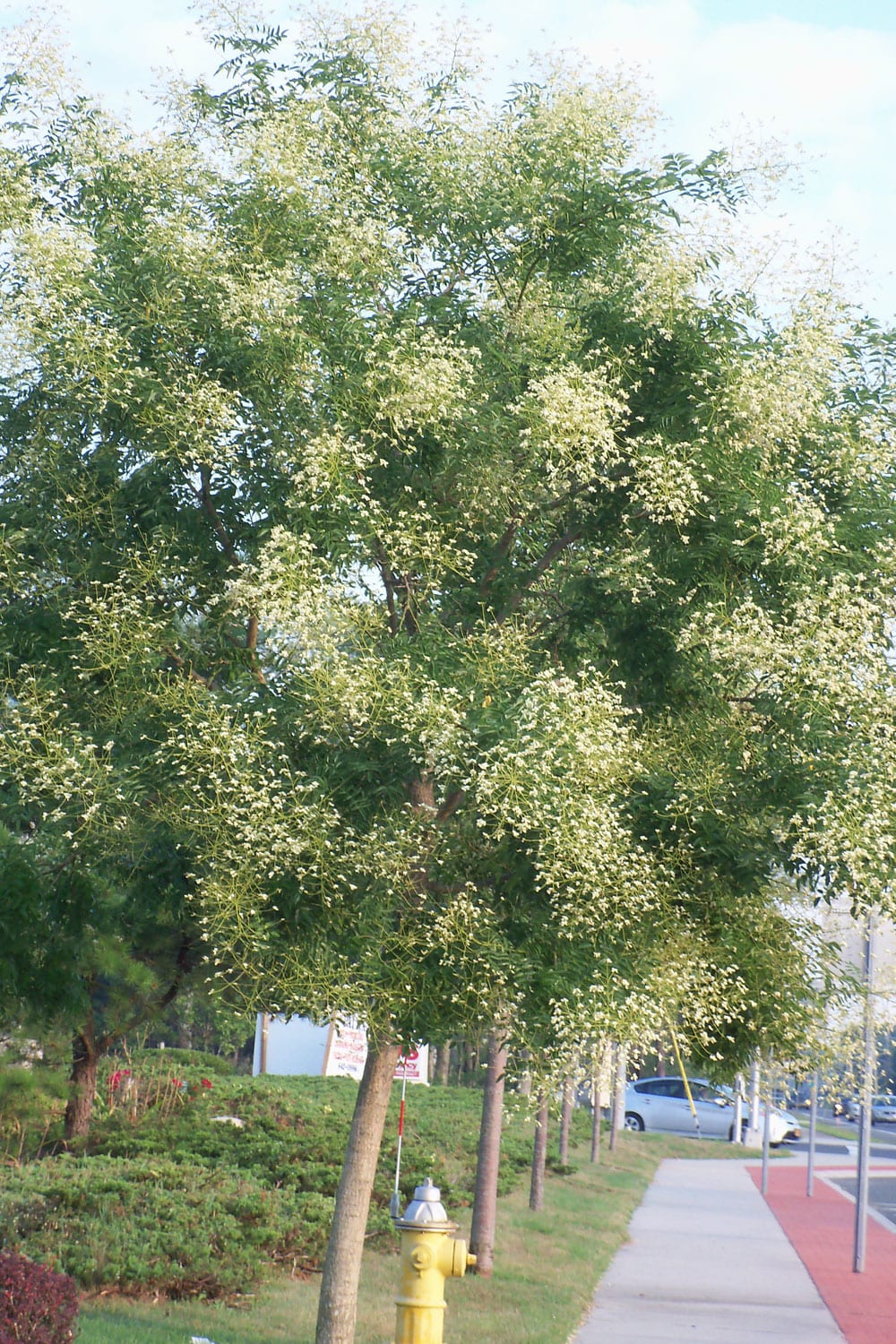japanese pagoda tree invasive
Little if any potential at this time Ozone sensitivity. Japanese Angelica Tree Aralia elata Pagoda Dogwood Cornus alternifolia Staghorn Sumac Rhustyphina Laciniata Cutleaf cultivar will spread Witch Hazel Hamemilis virginiana INVASIVE.
A Japanese Pagoda Tree Sophora Japonica L Planted In A Roadside Download Scientific Diagram
Preferred Scientific Name.

. Leguminosae USDA hardiness zones. Growing Japanese Pagodas If you want the ideal location for this tree plant it in full sun in soil that is rich in organic content. Alternatives to NYS Invasive Prohibited Plants TREES Invasive Alternatives.
Columnar scholar tree columnar Japanese pagoda tree Family. Styphnolobium japonicum L Schott. In the United States the tree is by and large considered non-invasive.
Fragrant creamy-white pea-shaped flowers 12mm in length produced in terminal panicles in mature trees. Not native to North America Invasive potential. It is resistant to pests drought and pollution.
Leguminosae USDA hardiness zones. It is a medium to large deciduous tree that typically matures to 50-75 less frequently to 100 tall with a broad rounded crown. The Japanese pagoda tree is often grown as a shade tree in lawns or on patios however flowers and seedpods often leave stains on pavement.
Is Japanese pagoda tree invasive. The domestication of this tree makes it difficult for it to survive without human care. In the United States the tree is by and large considered non-invasive.
Pagoda Dogwood Cornus alternifolia Canker disease is a problem in Eastern NY Witch Hazel Hamamelis virginiana. This species is native to eastern Asia China and Korea but has been introduced as an ornamental in North America Japan Europe North America and South Africa. These invasive species tiers guide management priorities in each PRISM and across New York State.
Trees do best in areas with full sun or partial shade and moderate amounts of water. Hardwood Trees Styphnolobium japonicum L Schott. Sophora japonica-- Scholar Tree Page 3 Other Figure 3.
It is by Robert Vidéki at Doronicum Kft. Japonicum is a large deciduous tree to 25m tall with a rounded low-branched habit and rich green pinnate leaves to 30cm in length. Japanese Pagoda Japanese pagoda is a large deciduous tree native to China It is an upright forming a lacy canopy of dark green pinnate leaves.
Sophora japonica Pendula known as the weeping Japanese pagoda is a cultivar of our Tree of the Month. Styphnolobium japonicum commonly called Japanese pagoda tree or Chinese scholar tree is native to China and Korea but not Japan. The Japanese pagoda tree is also called the Chinese scholar tree and the honey tree.
The soil should drain extremely well so choose sandy loams. This species does not appear on any state or national invasive species lists. 7 Japanese Pagoda Tree Sophora Japonica or Styphnolobium Japonicum 8 Jasmine Jasminum Officinale 9 Jewel Orchid Ludisia 10 Josephs Coat Amaranthus Tricolor 11 Juniper Juniperus A tropical tree the jacarandas branches are arched and they form an umbrella shaped canopy which means its an ideal tree for providing shade.
Surface roots are usually not a problem Winter interest. It has become invasive in DC Maryland North Carolina Ohio Pennsylvania and Virginia. To generate tiers for hundreds of invasive species we devised a new method that combines data from iMapInvasives with invasiveness assessments and expert feedback.
Japanese Angelica Tree Aralia elata. The weeping Japanese pagoda rarely blooms. Styphnolobium japonicum L Schott previously.
Fruits make very slippery ground when they fall. Honeylocust Gleditsia triacanthos var. No special winter interest Outstanding tree.
Japanese Angelica Tree Aralia elata. How do you care for a Japanese pagoda tree. Please contact us if a state or federal list needs to be updated.
5A through 8A Fig. Image 5399189 is of Japanese pagoda tree Styphnolobium japonicum trees. Once the Japanese pagoda tree is.
Use the filters below to generate tier lists for your region and use the. Staghorn Sumac Rhus typhina Dissecta Cutleaf cultivar will spread Amur Cork Tree Phellodendron. Palmatum plantanoides pseudoplatanus Japanese Norway Sycamore maple Invasive Actinidia arguta Hardy kiwi Threat Aegopodium podagraria Goutweed Invasive Agrostis capillaris Colonial bent-grass Invasive Ailanthus altissima Tree of Heaven Invasive Akebia quinata Five-leaved akebia Invasive Albizia julibrissin Mimosa Invasive.
Japanese pagoda trees can be found in various places around the District including on the Capitol grounds and at Dupont Circle Lincoln Park and the National Cathedral. The domestication of this tree makes it difficult for it to survive without human care. The first specimens seen in the west were gained from Japanese sources in the 1750 s hence its classification as a Japanese tree.
Foliage of Scholar Tree. Staghorn Sumac Rhus typhina Dissecta Cutleaf cultivar will spread Amur Cork Tree Phellodendron amurense. In the United States the tree is by and large considered non-invasive.
Are Japanese pagoda trees invasive. It showed exceptional vigor and was drastically different from the. A clusters of creamy white-green fragrant flowers appear in summer.
Seed pods appear in the summertime which can cause serious litter on the ground. Sophora japonica Where to Look. This plant is an invasive species in North Carolina Description NC State Universitys legendary plantsman the late JC Raulston found this wild plant in 1985 while visiting Korea.
It is hardy to -25F 317C. In 2006 Casey Trees named a Japanese. Tree has outstanding ornamental features and could be planted more Invasive potential.
5A through 8A Fig. Weeping scholar tree weeping Japanese pagoda tree Family. Pagoda Dogwood Cornus alternifolia Canker disease is a problem in Eastern NY Witch Hazel Hamamelis virginiana.
The Pagoda tree is capable of growing in all soil types although it grows best in well drained loamy soils and in full sun conditions. Not native to North America Invasive potential.

Japanese Pagoda Tbr News Media

Styphnolobium Japonicum Landscape Plants Oregon State University

Japanese Pagoda Tree Sophora Japonica 10 Seeds Namų Zona

Japanese Pagoda Tree Chinese Scholar Tree
Japanese Pagoda Tree Becoming Popular In U S Cities What Grows There Hugh Conlon Horticulturalist Professor Lecturer And Gardener

Japanese Pagoda Tree News From Rockcliff Farm

Japanese Pagoda Tree News From Rockcliff Farm

Styphnolobium Japonicum Landscape Plants Oregon State University

Japanese Pagoda Tree Sophora Japonica 10 Seeds Namų Zona

Japanese Pagoda Tree News From Rockcliff Farm

Sophora Japonica Pendula Trees Marcopolo Plants Fast Growing Shade Trees Shade Trees Garden Trees

Japanese Pagoda Tree Deciduous 15m 20m High Seed Pods Japanese Pagoda Amazing Gardens Tree

Japanese Pagoda Tree Styphnolobium Japonicum Fabales Fabaceae Leguminosae 5539402

Fast Growing Trees For Impatient Gardeners Finegardening
Japanese Pagoda Tree Becoming Popular In U S Cities What Grows There Hugh Conlon Horticulturalist Professor Lecturer And Gardener

Japanese Pagoda Tree Styphnolobium Japonicum Fabales Fabaceae Leguminosae 5539401

Japanese Pagoda Tree Styphnolobium Japonicum Fabales Fabaceae Leguminosae 5396099
